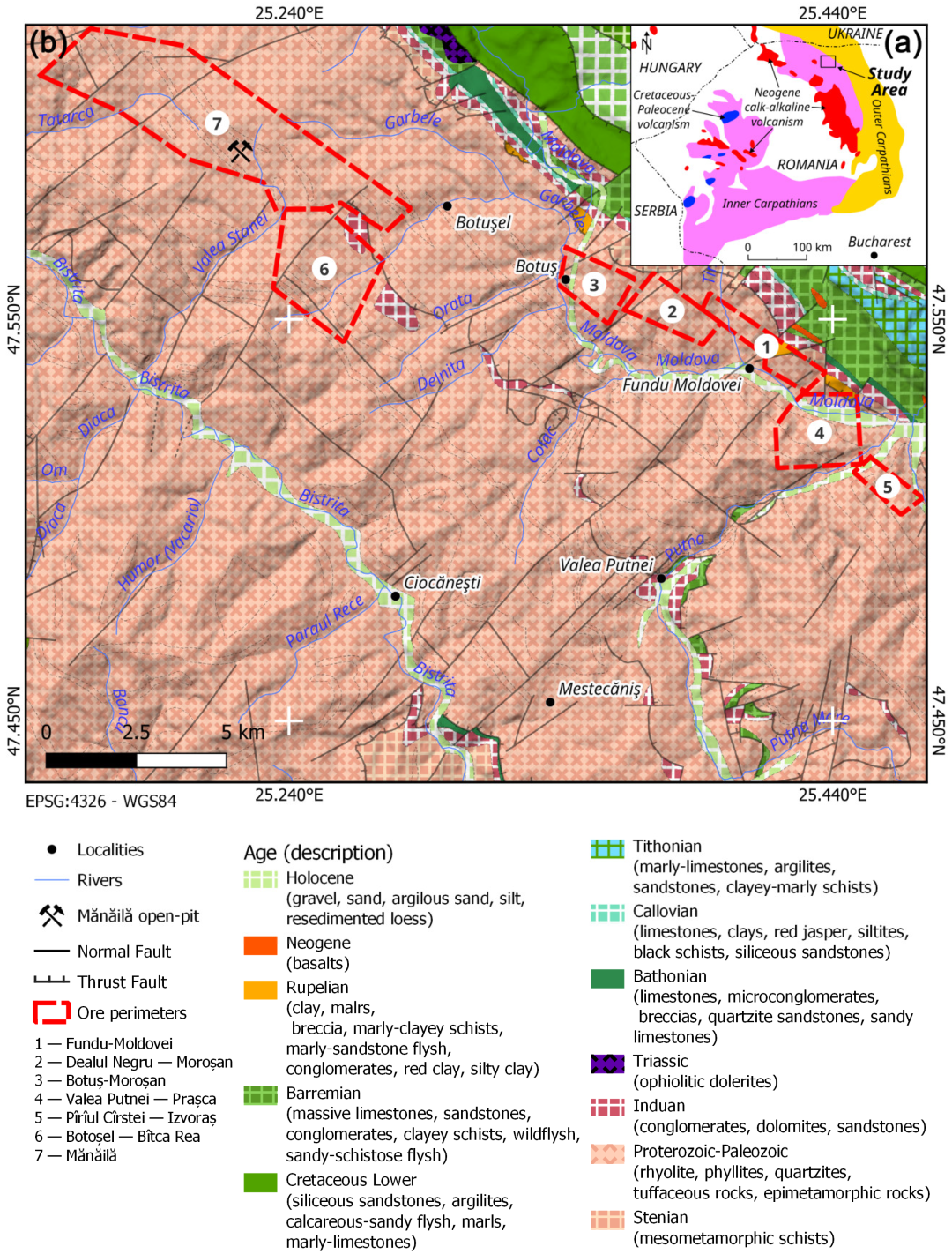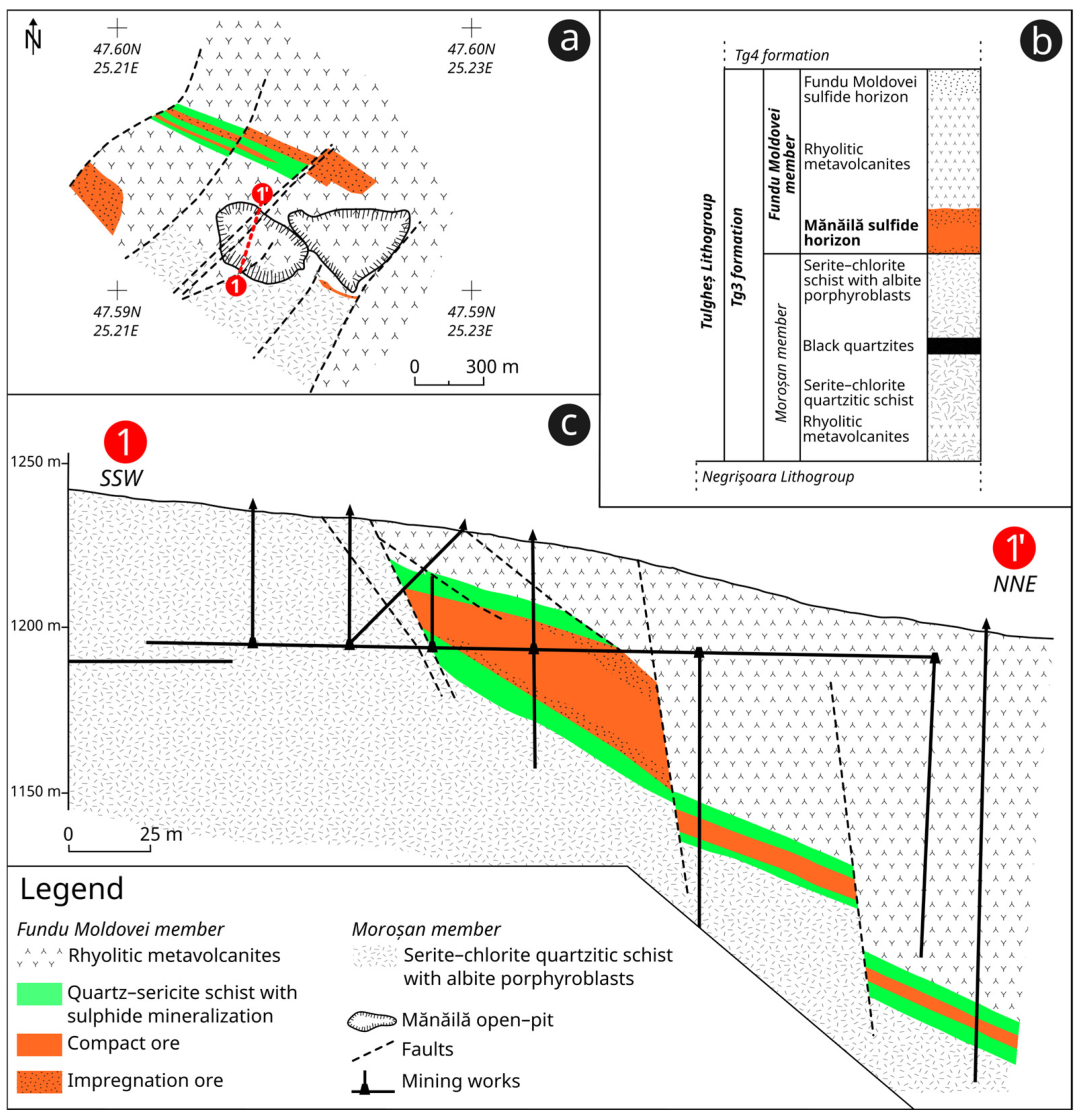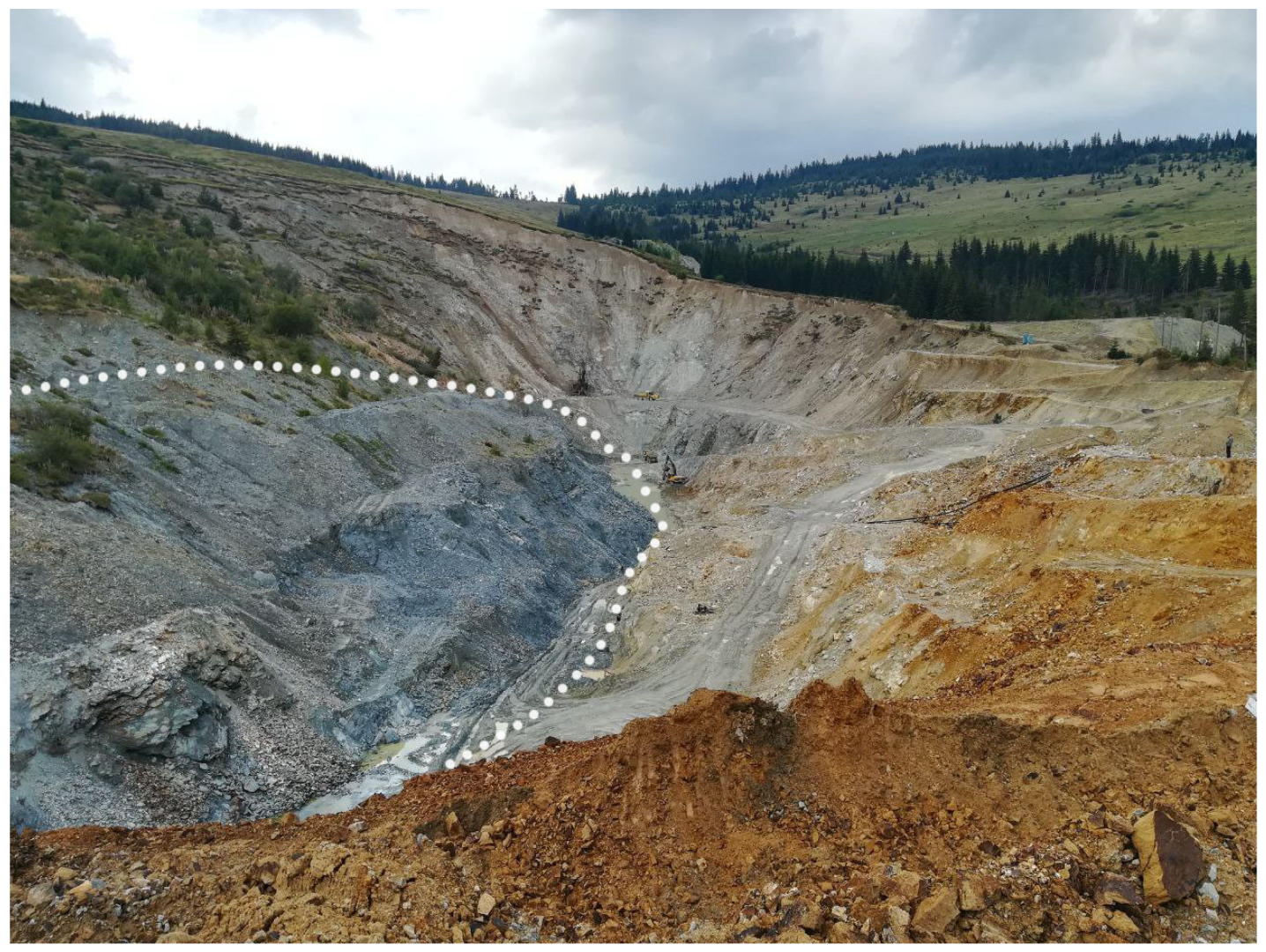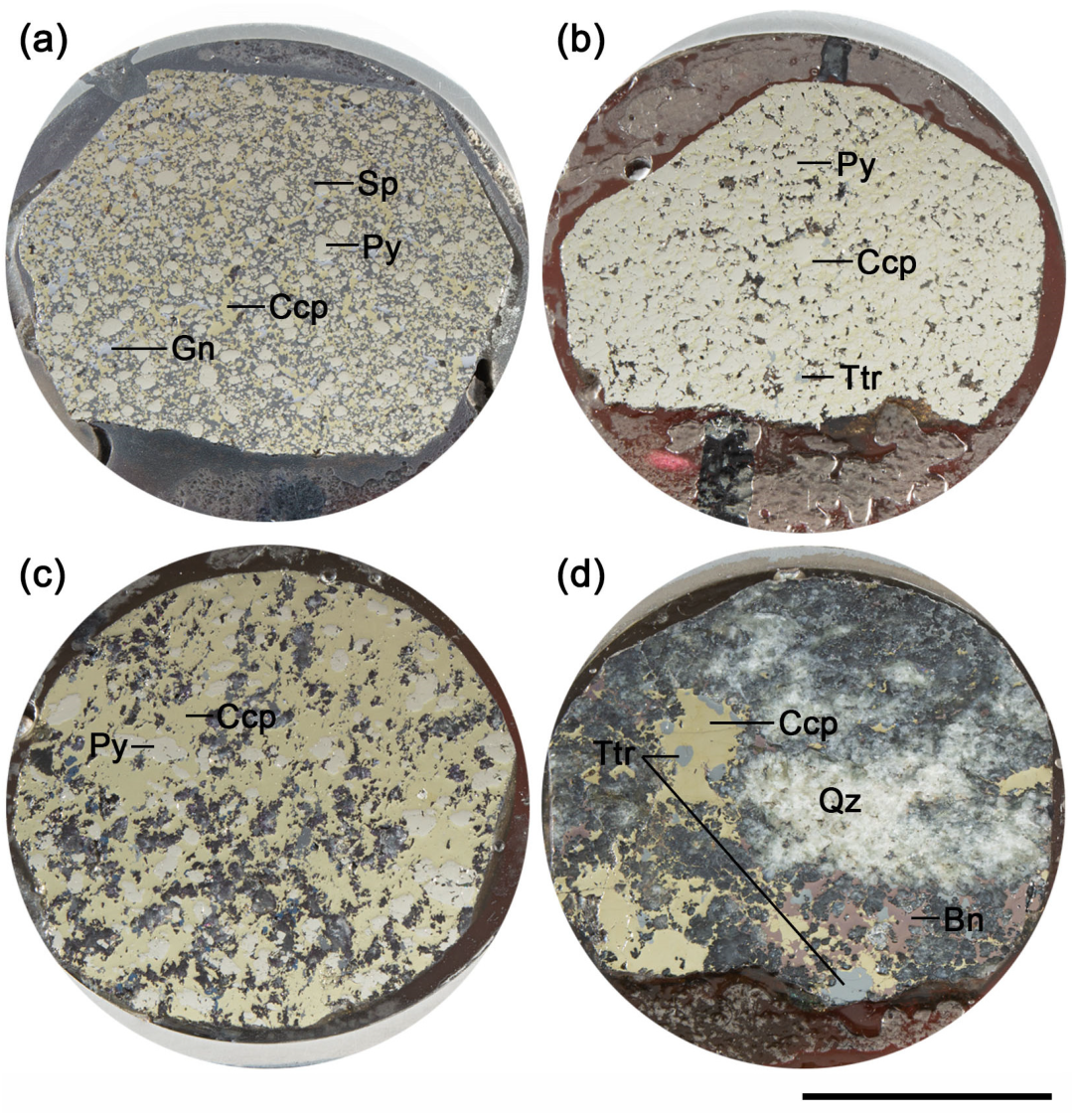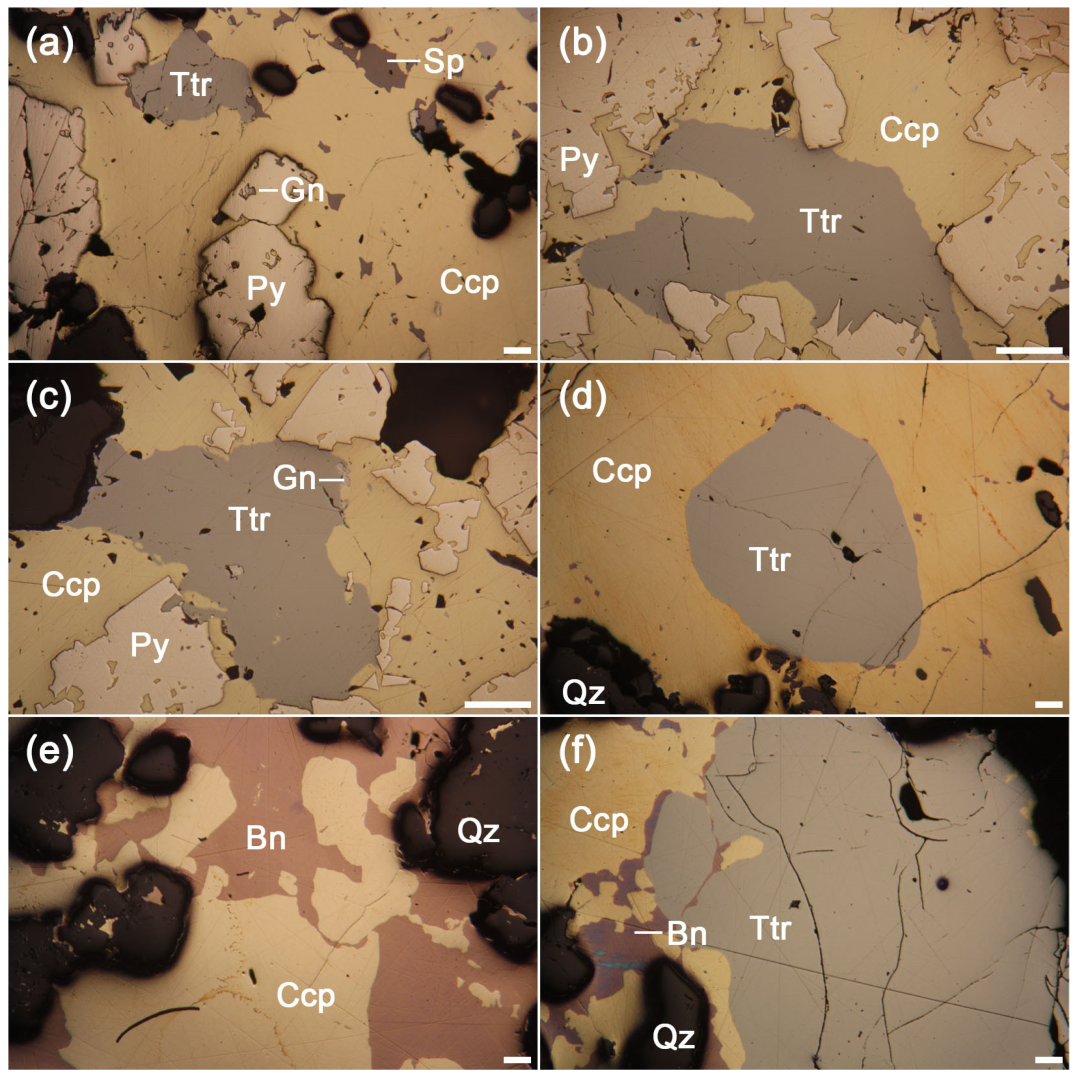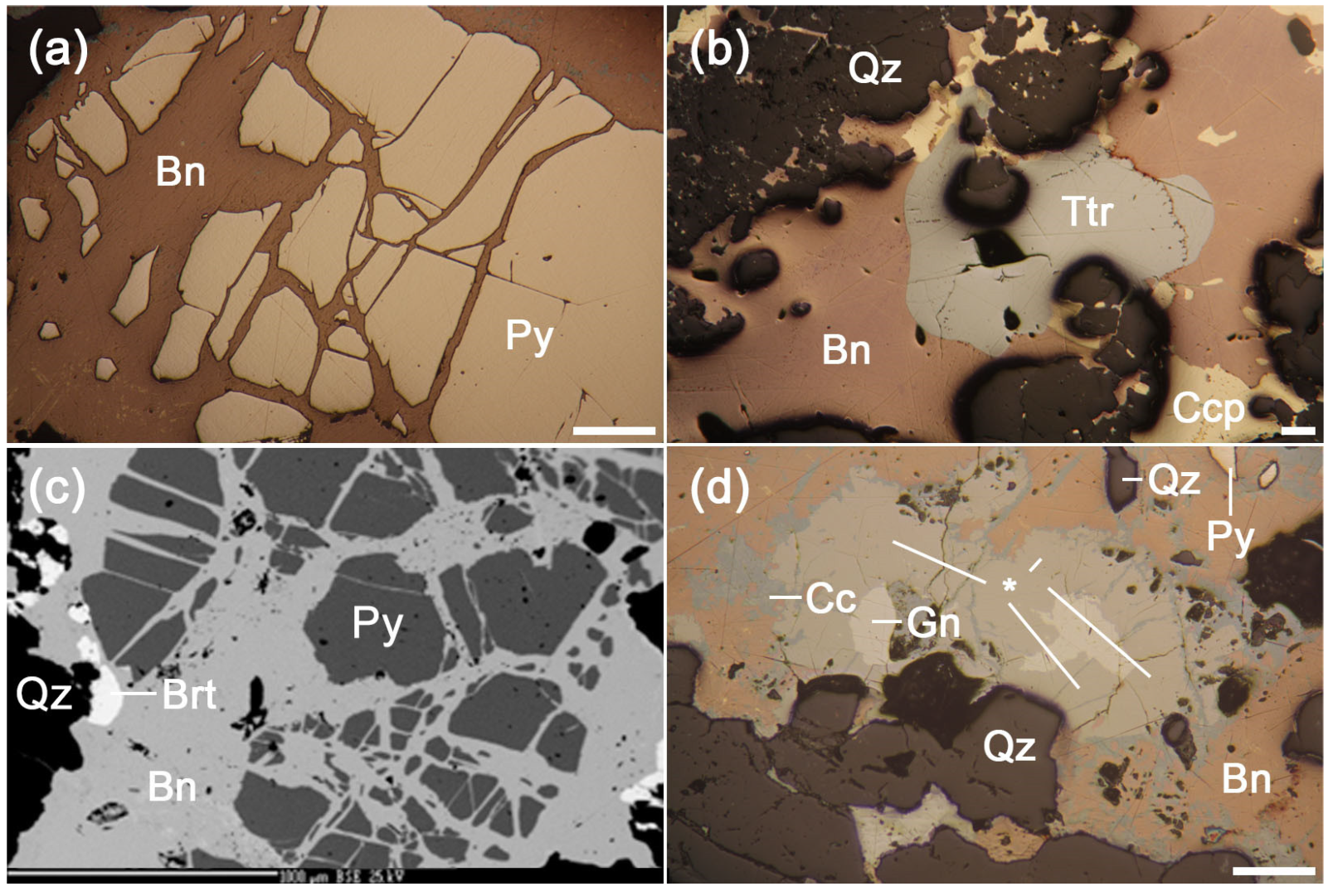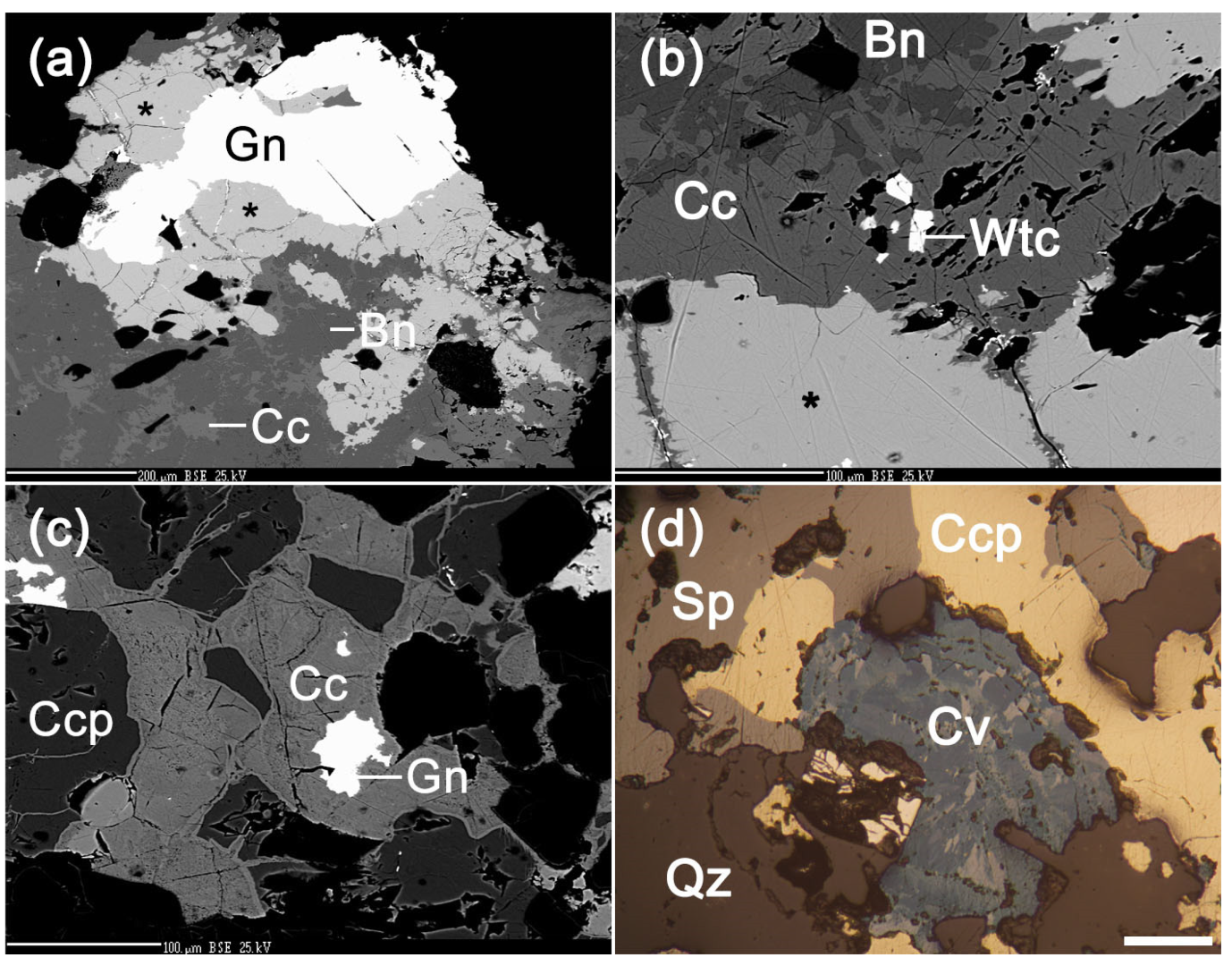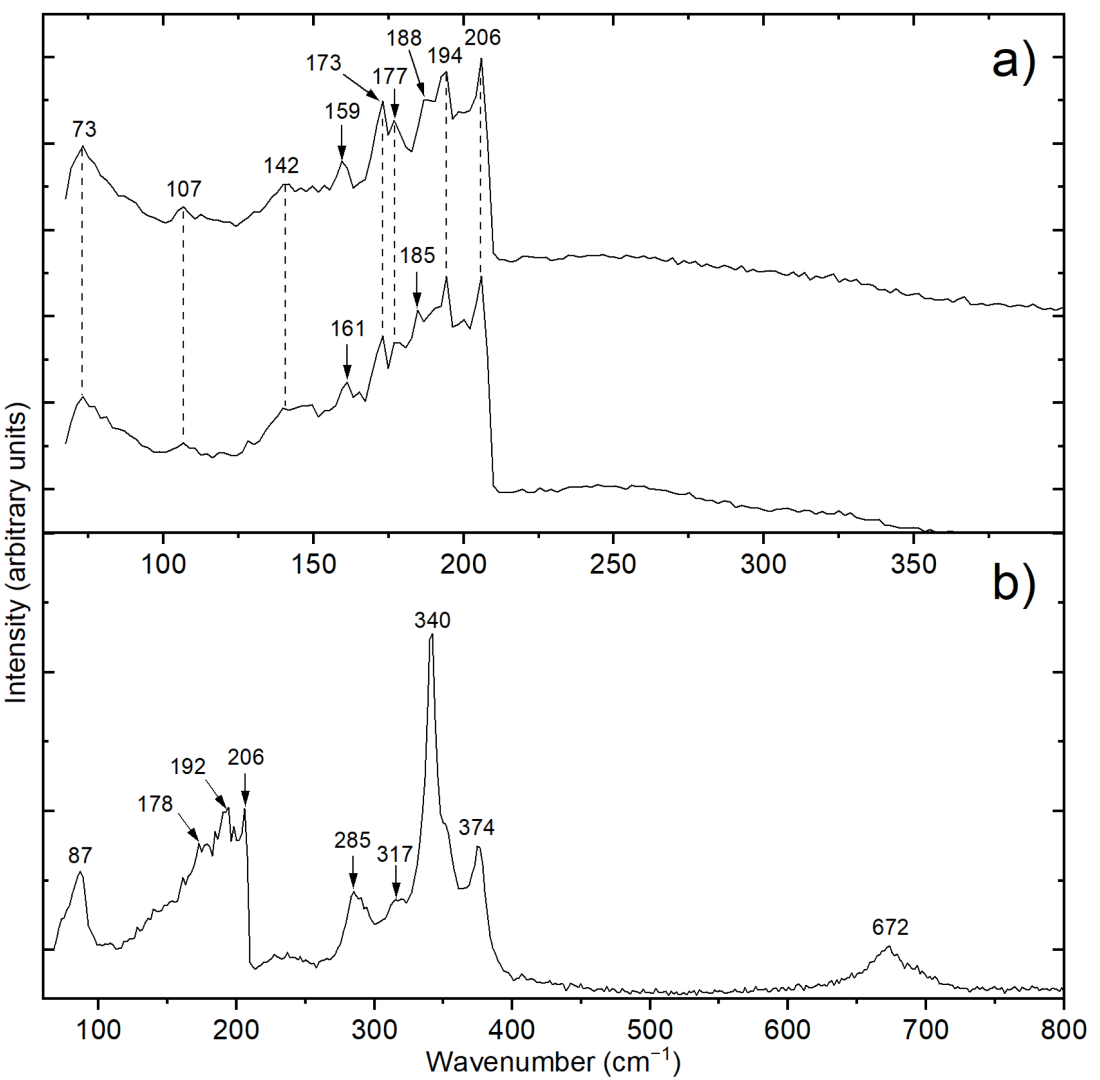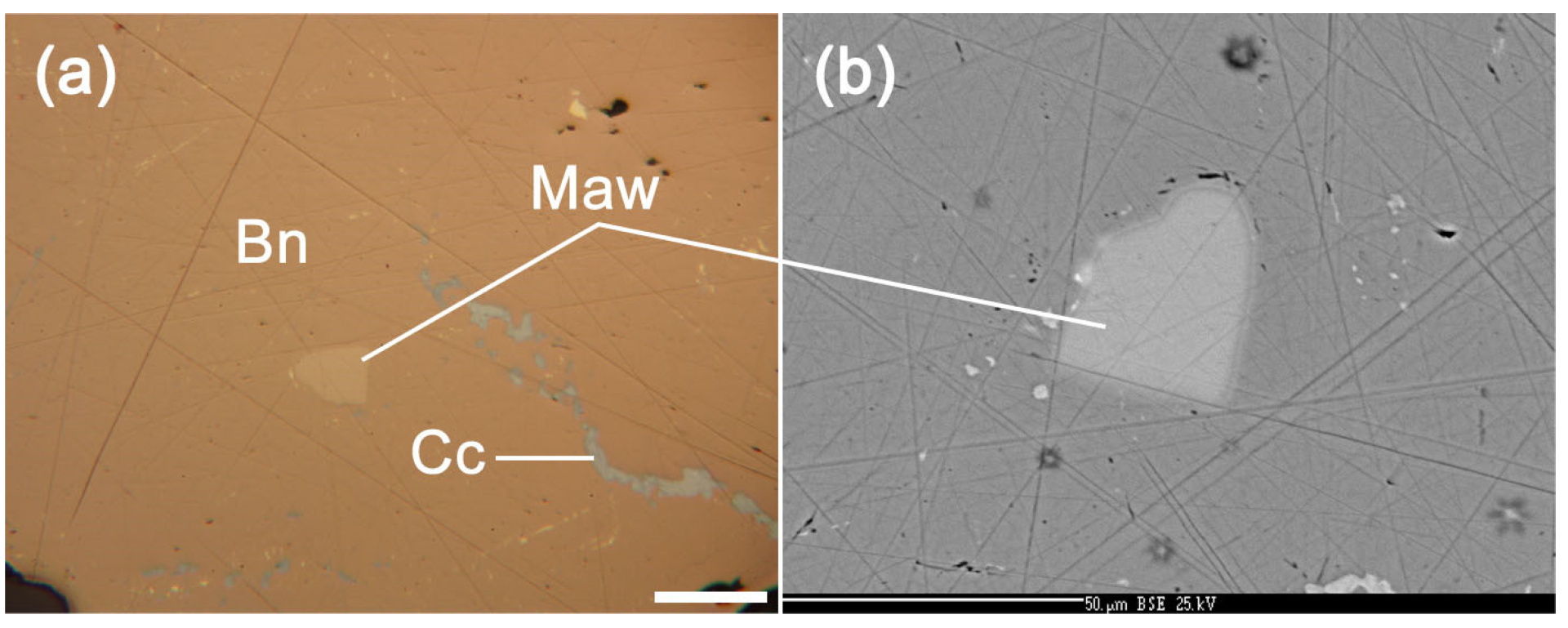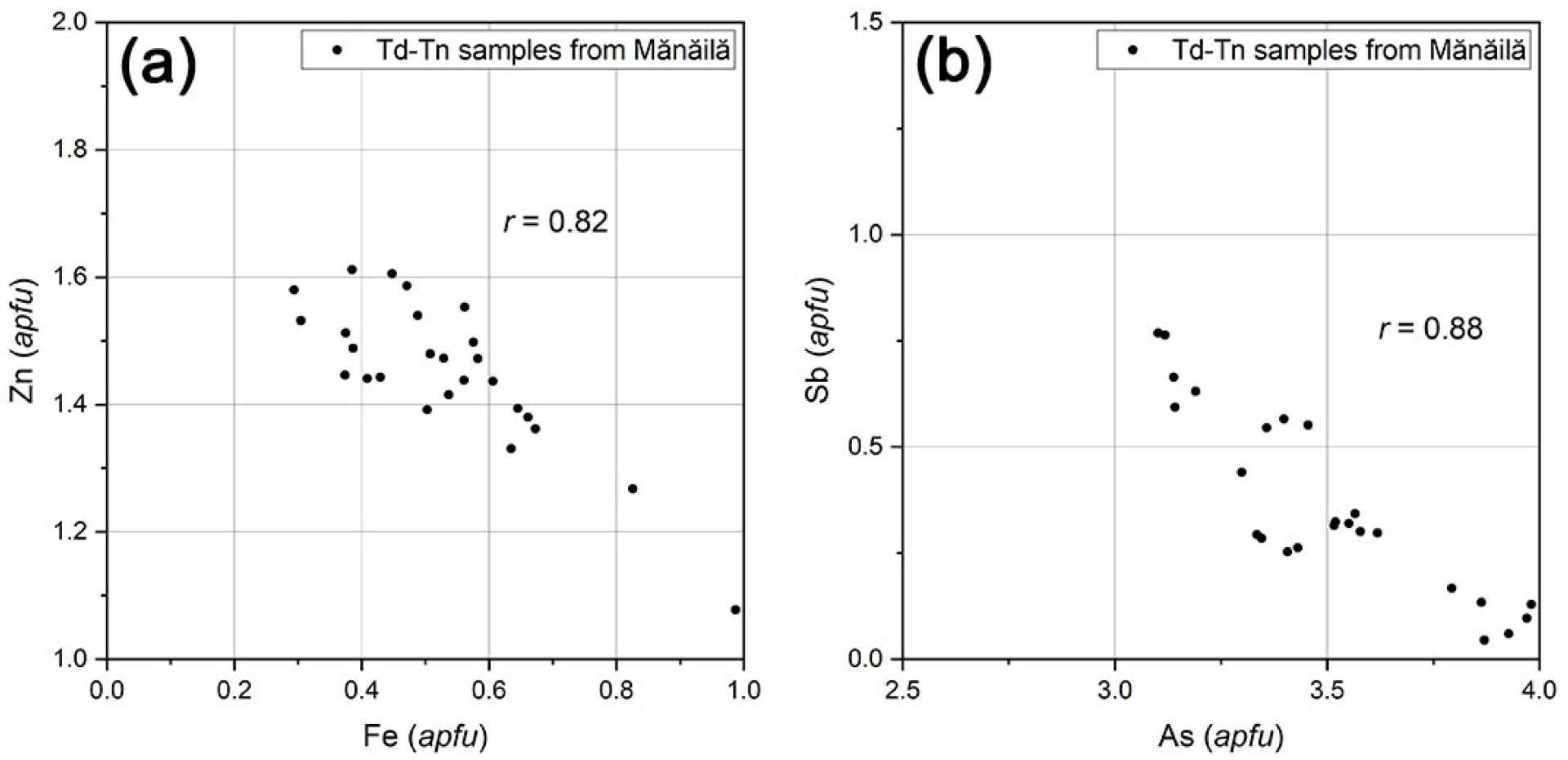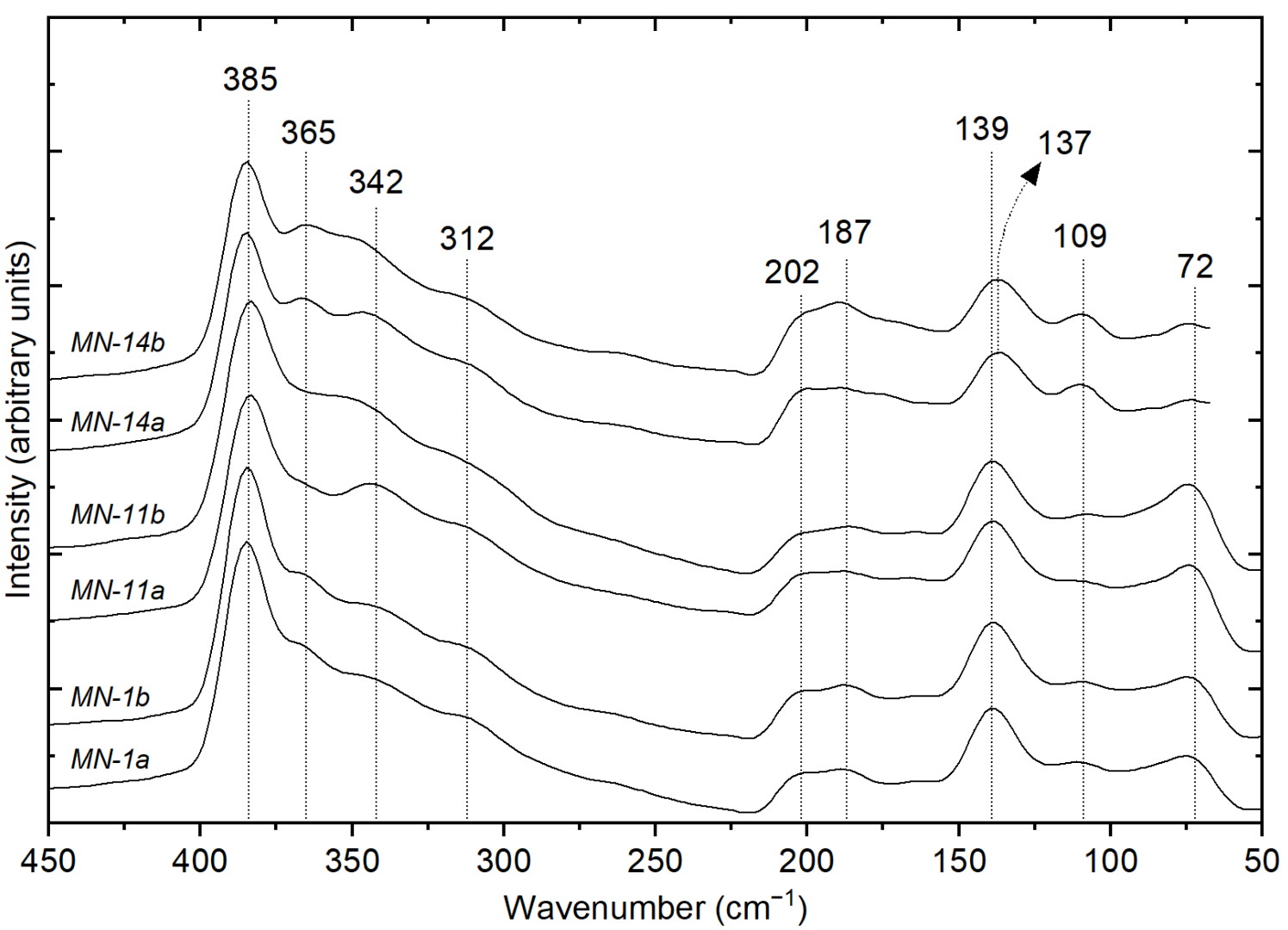4.3.1. Sulfides
Pyrite, chalcopyrite, sphalerite, and galena are major minerals; bornite, covellite, tetrahedrite, chalcocite, and arsenopyrite are minor, with accessory minerals of bismuth and tin.
Pyrite appears in a compact form in pyrite-polymetallic (
Figure 5a) and pyrite-copper ore (
Figure 5b,d) and is the common ore mineral in precompact and disseminated ore. Pyrite can be found in the form of subhedral and anhedral equigranular grains (
Figure 5a–c). Pyrite is spatially associated with copper-bearing sulfides, sphalerite, and galena (
Figure 5a–c). Pyrite grains are corroded by chalcopyrite and sometimes by sphalerite. In massive ores, fine-grained pyrite aggregates are predominant. Pyrite also has brecciated structures in the spaces created, more plastic chalcopyrite infiltrates under the influence of stress (
Figure 5a,b). Pyrite in compact ore is spatially associated with copper-bearing sulfides and sphalerite-galena.
Electron microprobe analysis indicates minor amounts of As, Ni, Co, Pb, Ag, and Mn in the pyrite (
Table 1). The pyrite is poor in As (<0.06 wt.%) but contains up to 0.05 wt.% Co; the other elements are insignificant. Impurities in the pyrite are incorporated into the crystal structure.
Sphalerite is more abundant in pyrite-polymetallic ore (
Figure 4a) than in copper ore (
Figure 4c). In the pyrite-polymetallic ore, it appears in the form of anhedral crystals of up to 1 mm intergrowth with chalcopyrite and galena and is arranged in the open spaces between the pyrite grains (
Figure 4a and
Figure 5c). Electron microprobe analysis (
Table 1) indicates sphalerite with low Fe and Mn content and 0.32 wt.% Cd content. Sphalerite contains impurities of Cu, Pb, and Ag, but no inclusions of other minerals were observed in the analyzed area.
Galena is a minor constituent intergrowth with sphalerite and chalcopyrite in pyrite-polymetallic ore (
Figure 4a and
Figure 5a) and inclusions in precompact quartz-copper ore. The silver content reaches up to 0.1 wt.% and the bismuth content up to 0.38 wt.% (
Table 1). The presence of copper was also highlighted but in insignificant quantities. These impurities are most likely present in the crystalline structure since no other minerals were observed as inclusions in the microprobe images.
Chalcopyrite is abundant in the Mănăilă ore deposit and occurs in high amounts in pyrite-copper (
Figure 4b), compact and precompact copper (
Figure 4c), and quartz-copper ore (
Figure 4d). It forms anhedral grains that border pyrite or compact masses with sphalerite, pyrite, galena, and tetrahedrite inclusions (
Figure 5d and
Figure 6a–d). Chalcopyrite is frequently intergrown with bornite and tetrahedrite in quartz-copper precompact ore (
Figure 6e,f). Chalcopyrite crosscuts the pyrite grains from compact pyrite ore (
Figure 5a). Electron microprobe data indicate minor amounts of As, Sn, Co, Ni, Mn, Bi, Pb, Zn, and Cd in the crystal structure of chalcopyrite (
Table 2).
Bornite is most abundant in the precompact quartz-copper ore and is present as anhedral millimetric grains intergrown with chalcopyrite (
Figure 6e) or as small inclusions in chalcopyrite. Very frequently, bornite crosscuts pyrite grains (
Figure 7a) or includes tetrahedrite grains (
Figure 7b) and chalcocite (
Figure 7c,d) in precompact quartz-copper ore. Bornite is replaced and corroded by covellite (
Figure 7d). Bornite contains up to 0.61 wt.% Ag and very minor amounts of Co, As, Sn, Ni, Bi, Sb, Te, Pb, Zn, and Cd (
Table 2). The microscopic textures (
Figure 7a) indicate the subsequent deposition of bornite after the regional metamorphism process.
Primary chalcocite is common in precompact quartz-copper ore along with chalcopyrite and bornite. It appears as an inclusion in the bornite and is corroded marginally and on cracks by covellite (
Figure 7c,d). Covellite rims are common in contact between bornite and chalcocite (
Figure 7d). Chalcocite and bornite frequently intergrow each other (
Figure 8a,b). Secondary chalcocite formed by the weathering of chalcopyrite (
Figure 8c) and as a pellicular form of sphalerite grains (
Figure 5c) has been identified in pyrite-polymetallic ore. The chemical composition of the two types of chalcocite is not much different, however, the difference can be noticed in the silver content; primary chalcocite contains more silver (0.76–1.89 wt.%) than secondary (0.35–0.49 wt.%) (
Table 2). The minor elements are also different, in secondary chalcocite Co is frequently present, and primary chalcocite contains As, Pb, and Zn.
Covellite is an accessory mineral formed by the alteration of primary copper sulfides. It appears as thin rims at the bornite–chalcocite contact (
Figure 7d), or on sphalerite and chalcopyrite (
Figure 8d). The chemical composition is simple (CuS), with few impurities (Fe, Ni) (
Table 2).
The unnamed mineral from Mănăilă was identified in a less typical association with bornite, chalcocite, and galena (
Figure 7d and
Figure 8a,b). Chalcocite and the unnamed mineral are substituted on cracks by covellite. According to this association, the unnamed mineral is a primary mineral and not a secondary one. The relief of the unnamed mineral is close to chalcocite and bornite and higher than galena. Its color is cream (
Figure 7d), with weak bireflection, and strong anisotropy with colors from gray to brown. The reflectivity is lower than galena and higher than bornite and chalcocite.
The electronic microprobe data of the unnamed mineral (
Table 3) indicate the presence of large amounts of Cu, Pb, and S. In smaller amounts, Fe and Ag substitute for Cu and Pb, respectively. Minor amounts of Zn, As, Cd, and Bi were also observed. The calculated formula for the unnamed mineral would be the following:
.
The Raman spectra of the unnamed mineral show the most intense peak at 206 cm
−1 (
Figure 9a). No other bands were observed at higher wavenumbers, only in the low-frequency region where several lines appear at 73, 159–161, 173, and 194 cm
−1. Additional peaks are present as shoulders or with lower intensities (
Figure 9a).
4.3.2. Sulfosalts
Mawsonite appears in the form of submillimeter inclusions in bornite (
Figure 10a,b). It is in the same association with many bornites as in the one described by Markham and Lawrence [
23]. The color is orange-pink, much lighter than bornite, and with a lower relief (
Figure 10a). It presents obvious bireflection and strong anisotropy with colors varying from light yellow to blue. The chemical analysis of mawsonite is presented in
Table 4. The crystallochemical formula is:
which is identical to the structural formula of mawsonite
.
The Raman spectrum of mawsonite is shown in
Figure 9b. The peaks are divided into four groups with the most intense one at 340 cm
−1 and the additional lines 285, 317, and 374 cm
−1. One vibrational mode appears at 672 cm
−1 while at lower wavenumbers, the Raman bands 178, 192, and 206 cm
−1 are observed. The lattice modes are shown at 87 cm
−1.
Wittichenite represents the first occurrence in the polymetallic massive sulfide mineralizations of the Eastern Carpathians, Romania. It appears in the form of 10–15 µm granules included in chalcocite (
Figure 8b). Electron microprobe data (
Table 5) indicate a wittichenite with small impurities of Sn, Fe, Ag, Sb, Pb, and Te that replace the main elements Cu, Bi, and S in its crystal structure. The chemical formula is
which corresponds to the structural one of wittichenite.
Tetrahedrite is the most common mineral from the sulfosalt group present in the VMS deposits of the Eastern Carpathian belt [
7,
9,
22,
24]. For the natural minerals of the tetrahedrite-tennantite series (
–
) the term “fahlore(s)” is frequently used [
25]. In the massive pyrite deposit in the Mănăilă perimeter, tetrahedrite appears in all types of mineralization, but especially in copper ores (
Figure 4b–d). The specific presentation of tetrahedrite in the type of compact ore is in the form of granules included in chalcopyrite that constitutes the matrix of subhedral pyrite crystals (
Figure 5a). In the copper ore, the tetrahedrite appears in the form of anhedral grains included in chalcopyrite (
Figure 4b and
Figure 6b–d). More widely developed tetrahedrite grains of 2 mm are associated with or included in chalcopyrite and bornite (
Figure 5d,
Figure 6f and
Figure 7b).
For tetrahedrites, 26 electron microprobe (EPMA) analyses were performed (
Table 6). The tetrahedrite from Mănăilă does not show a great compositional range, being represented by the arsenic end-member (tennantite). Fe and Zn substitute for Cu
2+ in the structure of tennantite from Mănăilă and are negatively correlated (
r = 0.82,
Figure 11a). When the Fe
apfu has values lower than 1, and if Cu
2+ is in excess, then Fe appears as Fe
3+ according to the data of [
26]. Fe+Zn exceeds the 2
apfu value because it probably represents Cu
2+ in excess or Cu
+. Trace amounts of Mn, Pb, and Cd substitute for Fe and Zn in the divalent
C sites, while low contents of Ag substitute replace Cu
+ up to 0.15
apfu in the tennantite structure. The predominant semimetal is As which appears between 3.10—4.15
afpu, indicating the presence of tennantite members. As expected, there is a strong negative correlation between As and Sb (
r = 0.88,
Figure 11b).
The high As contents correlate with sulfur concentration. Sb appears in lower amounts and its
apfu varies between 0.04–0.77. As and Sb occupy the
D sites in the tennantite structure. In some samples, As and Sb are substituted by Bi, but in most samples, Bi is below the detection limit. Bi occurs mostly in the copper mineralization up to 0.26
afpu. Bi contents in tetrahedrites were also reported by Buzatu et al. [
27] in hydrothermal mineralization from Baia Sprie, Eastern Carpathian. In almost all samples, a sulfur deficit is noted because the
afpu value is below 13, with some exceptions (
Table 7).
The average stoichiometric formula of tennantites calculated on the basis of 29 atoms is:
which is close to the ideal formula of tennantite [
28]. The tennantites formula from Mănăilă is slightly variable (
Table 7) because the values of As
afpu (3.10–4.15) and Sb
afpu (0.04–0.77) are in the same range of variation. It is obvious that the studied tennantites are homogeneous since the ratio Sb/(Sb + As) is close to zero (0.09), with a variation of 0.01–0.20, indicating a pure tennantite member.
In recent years, several Raman studies on tetrahedrite-tennantite solid solution series have pointed out systematic changes in terms of peak position and changes of relative intensity [
25,
29]. The fundamental modes (ν
1 to ν
4) of As-rich members of the series are clearly observed in the Raman spectra (
Figure 12). The most notable spectral feature is represented by the ν
1 mode located at 385 cm
−1 which can be assigned to the symmetric stretching of pyramidal groups AsS
3. The other fundamental modes are displayed as shoulders, as follows: antisymmetric stretching ν
3 at 365 cm
−1; symmetric bending ν
2 at 342 cm
−1; and antisymmetric bending ν
4 at 312 cm
−1. The lattice modes are observed in the low wavenumber region of the Raman spectra (below 202 cm
−1). Considering the previous Raman studies [
25,
29], the spectral features are in agreement with the chemistry (
Table 6 and
Table 7).
